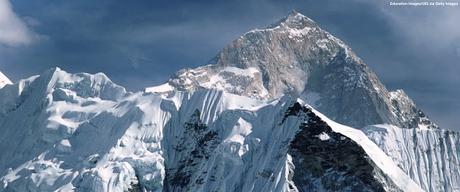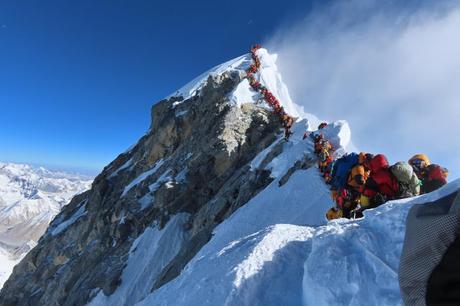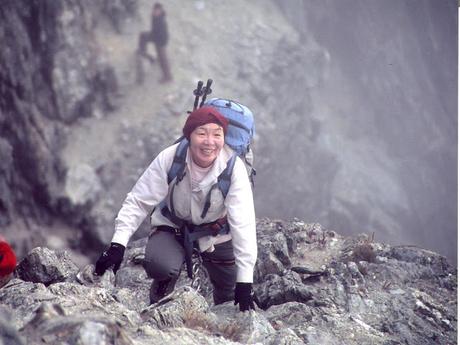The obvious reference is today’s Google doodle. Is it really a Sport – certainly one of a physical pursuit demanding an affinity for suffering. Where it is cerebral is in its requirement of good judgment, most importantly in extreme situations when the mind is most clouded and consequences of bad decision-making tend to multiply.Considering the level of risks of what the participants call the objective level, it involves assessing dangers one may encounter – weather, avalanches, poor rock, and many unthought of ! – really very tough challenges experienced and willfully pursued by mankind. .. .. it is conquering Mount Everest called ‘mountaineering’ !
 The world’s highest
mountain peak Mount Everest is called Chomolungma in
Tibetan and Sagarmāthāin Nepali.Mount Everest, located on the top of the
world, attracts people.Sagarmāthā is
Earth's highest mountain. Its peak is 8,848 metres (29,029 ft)~ although more than 4,000 people have scaled
the summit since Sir Edmund Hilary and Sherpa Tenzing Norgay first conquered
the mountain in 1953, hundreds have also perished.Statistics reveal that scaling Everest is
much easier than it used to be. In 1990 just 18 per cent of summit attempts
were successful, but in 2012 that figure was 56 per cent.
Turning
the annals of History, in1856, the
Great Trigonometric Survey of British India established the first published
height of Everest, then known as Peak XV, at 29,002 ft (8,840 m). In 1865,
Everest was given its official English name by the Royal Geographical Society
upon recommendation of Andrew Waugh, the British Surveyor General of India at
the time, who named it after his predecessor in the post, and former chief, Sir
George Everest. It is stated that
Waugh was unable to propose an established local name !but
why he chose not to name the Tibetan or Nepali name ? – remember the others Kangchenjunga,
Dhaulagiri etc.,the name
Chomolungma,reportedly appears on a
1733 map published in Paris.It had been
the practice to assign to every geographical object its true local or native
appellation but the highest peak was given a British name, despite the fact it
could not be written in native languages.
The highest
mountain in the worldhas challenged
climbers – it is stated that technically climbingK2 or Nanga Parbat are more difficult. Yet, Hundreds
have perished unable to complete the expedition. The last days of Mount Everest’s spring window
for 2019 witnessed the deaths of 11 climbers. Images of hundreds of
mountaineers queuing to reach the summit and reports of climbers stepping over
dead bodies dismayed people around the world, many wondering how human beings
had got it so wrong.After the conquest
of Annapurna and Everest in the 1950s, mountaineering became popular among the
more privileged. But in the past two decades, mountaineering has taken on a
increasingly commercial angle with disastrous results.
New Zealand’s Edmund Hillary and his Nepalese guide, Tenzing Norgay, were the first people confirmed to have reached the top of Everest, in 1953. In the decades that followed, only the most experienced climbers set out for the summit, often after years of training. But the 1990s brought the commercial era to the mountain—with catastrophic results at times. Hundreds of people have died over the years. Some recent climbers have stated that climbing Everest is climbing over dead bodies. It’s not hard to see why. As the expedition company Seven Summit Treks advertises: “If you want to experience what it feels like to be on the highest point on the planet and have strong economic background to compensate for your old age and your fear of risks you can sign up for the VVIP Mount Everest Expedition Service.” You need the “strong economic background” because it will cost you $130,000. There are less expensive ways to climb Everest, but they all start with the $11,000 fee that the Nepalese government charges for a permit. There cannot be any objection to Nepal Govt seeking revenue from wealthy foreign climbers. But even with the best support money can buy, in the thin air above 8,000 meters, people die ~ there are at least 200 bodies still on the mountain, some in crevasses, others buried by avalanches.
The world’s highest
mountain peak Mount Everest is called Chomolungma in
Tibetan and Sagarmāthāin Nepali.Mount Everest, located on the top of the
world, attracts people.Sagarmāthā is
Earth's highest mountain. Its peak is 8,848 metres (29,029 ft)~ although more than 4,000 people have scaled
the summit since Sir Edmund Hilary and Sherpa Tenzing Norgay first conquered
the mountain in 1953, hundreds have also perished.Statistics reveal that scaling Everest is
much easier than it used to be. In 1990 just 18 per cent of summit attempts
were successful, but in 2012 that figure was 56 per cent.
Turning
the annals of History, in1856, the
Great Trigonometric Survey of British India established the first published
height of Everest, then known as Peak XV, at 29,002 ft (8,840 m). In 1865,
Everest was given its official English name by the Royal Geographical Society
upon recommendation of Andrew Waugh, the British Surveyor General of India at
the time, who named it after his predecessor in the post, and former chief, Sir
George Everest. It is stated that
Waugh was unable to propose an established local name !but
why he chose not to name the Tibetan or Nepali name ? – remember the others Kangchenjunga,
Dhaulagiri etc.,the name
Chomolungma,reportedly appears on a
1733 map published in Paris.It had been
the practice to assign to every geographical object its true local or native
appellation but the highest peak was given a British name, despite the fact it
could not be written in native languages.
The highest
mountain in the worldhas challenged
climbers – it is stated that technically climbingK2 or Nanga Parbat are more difficult. Yet, Hundreds
have perished unable to complete the expedition. The last days of Mount Everest’s spring window
for 2019 witnessed the deaths of 11 climbers. Images of hundreds of
mountaineers queuing to reach the summit and reports of climbers stepping over
dead bodies dismayed people around the world, many wondering how human beings
had got it so wrong.After the conquest
of Annapurna and Everest in the 1950s, mountaineering became popular among the
more privileged. But in the past two decades, mountaineering has taken on a
increasingly commercial angle with disastrous results.
New Zealand’s Edmund Hillary and his Nepalese guide, Tenzing Norgay, were the first people confirmed to have reached the top of Everest, in 1953. In the decades that followed, only the most experienced climbers set out for the summit, often after years of training. But the 1990s brought the commercial era to the mountain—with catastrophic results at times. Hundreds of people have died over the years. Some recent climbers have stated that climbing Everest is climbing over dead bodies. It’s not hard to see why. As the expedition company Seven Summit Treks advertises: “If you want to experience what it feels like to be on the highest point on the planet and have strong economic background to compensate for your old age and your fear of risks you can sign up for the VVIP Mount Everest Expedition Service.” You need the “strong economic background” because it will cost you $130,000. There are less expensive ways to climb Everest, but they all start with the $11,000 fee that the Nepalese government charges for a permit. There cannot be any objection to Nepal Govt seeking revenue from wealthy foreign climbers. But even with the best support money can buy, in the thin air above 8,000 meters, people die ~ there are at least 200 bodies still on the mountain, some in crevasses, others buried by avalanches.
 The photograph of a
traffic jam of climbers leading to the summit of Mount Everest in May went
viral, evidence of the mountain’s surging appeal among thrill-seekers and the
overcrowding that has caused deaths and pollution. The photographer — Nirmal
Purja, known as Nims — is a Nepali mountaineer who has been on a journey to
climb the world’s tallest peaks in rapid succession, showcasing local climbers
as central actors in the history of Himalayan feats. He and his all-star Sherpa
team call the mission Project Possible, with a goal of summiting all 14 of the
world’s peaks higher than 8,000 meters (a little more than 26,000 feet) in
seven months. So far, since beginning in April, he has climbed 11 of them,
sometimes reaching the top of mighty peaks like K2 and Broad Peak in the span
of a weekend, something that took previous generations of mountaineers months,
if not years, to accomplish.Sadly, this year overcrowding on the mountain caused
human traffic jams along the narrow ridge leading to the top, contributing to
the high death toll.
Today Google
celebrates 80th birthday of a woman who was the first to scale Mount
Everest. Her group used the same route
to ascend the mountain that Sir Edmund Hillary and Tenzing Norgay had taken in
1953. In early May, the group was camping at 6,300 meters when an avalanche
struck their camp. The women and their guides were buried under the snow. Tabei
lost consciousness for approximately six minutes until her sherpa guide dug her
out. Twelve days after the avalanche, on 16 May
1975, with her sherpa guide, Ang Tsering, Tabei became the first woman to reach
the summit of Everest.
The photograph of a
traffic jam of climbers leading to the summit of Mount Everest in May went
viral, evidence of the mountain’s surging appeal among thrill-seekers and the
overcrowding that has caused deaths and pollution. The photographer — Nirmal
Purja, known as Nims — is a Nepali mountaineer who has been on a journey to
climb the world’s tallest peaks in rapid succession, showcasing local climbers
as central actors in the history of Himalayan feats. He and his all-star Sherpa
team call the mission Project Possible, with a goal of summiting all 14 of the
world’s peaks higher than 8,000 meters (a little more than 26,000 feet) in
seven months. So far, since beginning in April, he has climbed 11 of them,
sometimes reaching the top of mighty peaks like K2 and Broad Peak in the span
of a weekend, something that took previous generations of mountaineers months,
if not years, to accomplish.Sadly, this year overcrowding on the mountain caused
human traffic jams along the narrow ridge leading to the top, contributing to
the high death toll.
Today Google
celebrates 80th birthday of a woman who was the first to scale Mount
Everest. Her group used the same route
to ascend the mountain that Sir Edmund Hillary and Tenzing Norgay had taken in
1953. In early May, the group was camping at 6,300 meters when an avalanche
struck their camp. The women and their guides were buried under the snow. Tabei
lost consciousness for approximately six minutes until her sherpa guide dug her
out. Twelve days after the avalanche, on 16 May
1975, with her sherpa guide, Ang Tsering, Tabei became the first woman to reach
the summit of Everest.
 Even though Junko
Tabei was the first woman to reach the summit of Mount Everest, the highest
mountain on Earth, the Japanese mountaineer was never comfortable with that
distinction. "I was the 36th person to climb Everest," she told
Sports Illustrated in 1996. She was also the first woman to complete the Seven
Summits, reaching the highest peaks on each of the seven continents in 1992.
Although she was the first to summit Everest, it's apparently for the latter
achievement that Google is honoring Tabei on this Sunday with an animated Doodle on her 80th
birthday. For almost as long as Google has been around, it's livened up its
bare-bones search page with artwork that draws attention to notable people,
events, holidays and anniversaries. It typically embellished the letters in its
Doodle with other objects that resemble the letters, but this time the six
letters in Google have been replaced with seven peaks being conquered by a
cartoon version of Tabei.
Born on this day in
Miharu, Fukushima, in 1939, Tabei began climbing at the age of 10, even though
she was considered a frail child. In 1969, she founded a women's climbing club
after being treated poorly by male mountaineers, some of whom refused to climb
with her. The club's slogan was "Let's go on an overseas expedition by
ourselves."In 1975, she defied
Japanese societal norms again when she left her young daughter with her husband
while she traveled to Nepal to lead a group climbing Everest. "Back in
1970s Japan, it was still widely considered that men were the ones to work
outside and women would stay at home," Tabei told the Japan Times in 2012.
"Even women who had jobs -- they were asked just to serve tea. So it was
unthinkable for them to be promoted in their workplaces.
But her greatest
hurdle on the journey came when she was pinned under four climbing companions
by an avalanche at their camp more than 20,000 feet up the mountain. She lost
consciousness for about six minutes before her Sherpa guides dragged her out of
the snow by her ankles. "As soon as I knew everyone was alive, I was
determined to continue," she told SI. Her injuries prevented her from
being able to stand until two days after the avalanche, but 12 days after the
disaster, Tabei would become the first woman to stand on the Earth's highest
peak.
She stayed active
in the climbing community for the rest of her life, focusing her energies on
the environmental damage Everest suffers from waste left behind by climbers and
participating in many climbs designed to clean up that litter. In all, Tabei
climbed 69 major mountains in more than 60 countries and continued to climb
after she was diagnosed with cancer in 2012. She died four years later, on Oct.
20, 2016, at the age of 77.
Salute her spirit
of adventure .. and her accomplishment of conquering Mount Everest
With regards – S.
Sampathkumar
22nd
Sept. 2019
Even though Junko
Tabei was the first woman to reach the summit of Mount Everest, the highest
mountain on Earth, the Japanese mountaineer was never comfortable with that
distinction. "I was the 36th person to climb Everest," she told
Sports Illustrated in 1996. She was also the first woman to complete the Seven
Summits, reaching the highest peaks on each of the seven continents in 1992.
Although she was the first to summit Everest, it's apparently for the latter
achievement that Google is honoring Tabei on this Sunday with an animated Doodle on her 80th
birthday. For almost as long as Google has been around, it's livened up its
bare-bones search page with artwork that draws attention to notable people,
events, holidays and anniversaries. It typically embellished the letters in its
Doodle with other objects that resemble the letters, but this time the six
letters in Google have been replaced with seven peaks being conquered by a
cartoon version of Tabei.
Born on this day in
Miharu, Fukushima, in 1939, Tabei began climbing at the age of 10, even though
she was considered a frail child. In 1969, she founded a women's climbing club
after being treated poorly by male mountaineers, some of whom refused to climb
with her. The club's slogan was "Let's go on an overseas expedition by
ourselves."In 1975, she defied
Japanese societal norms again when she left her young daughter with her husband
while she traveled to Nepal to lead a group climbing Everest. "Back in
1970s Japan, it was still widely considered that men were the ones to work
outside and women would stay at home," Tabei told the Japan Times in 2012.
"Even women who had jobs -- they were asked just to serve tea. So it was
unthinkable for them to be promoted in their workplaces.
But her greatest
hurdle on the journey came when she was pinned under four climbing companions
by an avalanche at their camp more than 20,000 feet up the mountain. She lost
consciousness for about six minutes before her Sherpa guides dragged her out of
the snow by her ankles. "As soon as I knew everyone was alive, I was
determined to continue," she told SI. Her injuries prevented her from
being able to stand until two days after the avalanche, but 12 days after the
disaster, Tabei would become the first woman to stand on the Earth's highest
peak.
She stayed active
in the climbing community for the rest of her life, focusing her energies on
the environmental damage Everest suffers from waste left behind by climbers and
participating in many climbs designed to clean up that litter. In all, Tabei
climbed 69 major mountains in more than 60 countries and continued to climb
after she was diagnosed with cancer in 2012. She died four years later, on Oct.
20, 2016, at the age of 77.
Salute her spirit
of adventure .. and her accomplishment of conquering Mount Everest
With regards – S.
Sampathkumar
22nd
Sept. 2019

